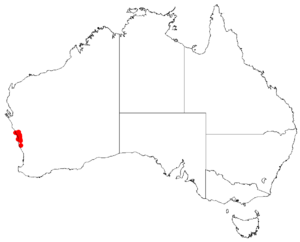Hakea polyanthema facts for kids
Quick facts for kids Hakea polyanthema |
|
|---|---|
| Scientific classification | |
| Genus: |
Hakea
|
| Species: |
polyanthema
|
 |
|
| Occurrence data from Australasian Virtual Herbarium | |
Hakea polyanthema is a special kind of shrub found only in Western Australia. It belongs to a plant family called Proteacea. This shrub is known for its many small flowers that grow close to the leaves. These flowers have a scent that some people might find a bit unpleasant.
What it Looks Like
Hakea polyanthema is a bushy shrub with many branches. It usually grows to be about 1 to 2 meters (3 to 6 feet) tall. Its small branches are covered in tiny hairs.
When new leaves and branches grow, they have short, flat, silky hairs that look a bit rusty in color. The leaves are smooth and shaped like needles. They are about 0.8 to 1.2 millimeters long and 0.8 to 1.5 millimeters wide. These leaves can be straight or slightly curved, and they end in a sharp point.
The shrub produces small flowers that grow where the leaves meet the stem. You might see 2, 4, or 6 flowers together. They can be white, pink, or even deep red. Each flower has tiny leaf-like parts called bracts, which are about 1.3 millimeters long. The flower stems, called pedicels, are 1.5 to 2.5 millimeters long and covered in silky, white or creamy hairs.
The main part of the flower, called the perianth, is 3.5 to 4.2 millimeters long. It has cream-yellow or white hairs near its base, but further along, the hairs are rusty colored. The part of the flower that helps it make seeds, called the pistil, is about 5 millimeters long.
After flowering, the plant grows upright, oval-shaped fruits. These fruits are 25 to 35 millimeters (about 1 to 1.4 inches) long and 1.5 to 1.9 millimeters wide. They feel a bit like cork and have a sharp tip that is about 3.5 millimeters long. Inside these fruits are seeds, which are around 25 millimeters (1 inch) long. Each seed has a wing around its body, which helps it fly away in the wind. This plant flowers from August to September.
Naming and History
The scientific name for this plant, Hakea polyanthema, was first officially described in 1904. This was done by a scientist named Ludwig Diels. He wrote about it in a scientific journal called Botanische Jahrbücher für Systematik, Pflanzengeschichte und Pflanzengeographie.
The second part of its name, polyanthema, comes from two Greek words: "poly-", which means "many", and "anthemon", which means "flower". This name probably refers to how many flowers this plant produces, making it look very dense with blooms.
Where it Lives
This special plant is found only in a small part of Western Australia. You can find it along the west coast, in the Mid West region, and in the Wheatbelt area. It grows between the towns of Geraldton and Dandaragan.
Hakea polyanthema likes to grow in sandy soils, loam (a mix of sand, silt, and clay), and gravel. It is often found in areas with scrubland (bushes and small trees) and heath (open land with small shrubs).

